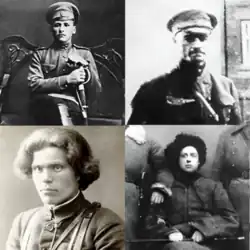Atamanshchina

Atamanshchina (Russian: атаманщина), otamanshchyna (Ukrainian: Отаманщина, Отаманія[1]), or atamanism[a] is a political situation during the Russian Civil War in Ukraine and in some parts of Russia with absent or weak central power, some areas were ruled by warlords, typically Cossack atamans.[3][4] In Ukraine, these atamans showed lack of subordination towards the Second Hetmanate and later towards the Directorate of Ukraine.[5][6]
Over time the term acquired the generic meaning of the decentralized rule of warlords.
See also
- Makhnovshchina
- Conchoprimismo, a similar phenomenon in the history of Dominican Republic
- Green armies
Notes
- ^ In this context, the suffix -shchina is basically equivalent to -ism,[2] only usually it has negative connotations, as in "Yezhovshchina".
References
- ^ Українська мала енциклопедія, vol. 10, 1962, Buenos-Aires, ОЛ - ПЕ
- ^ -щин-(а), from Современный толковый словарь русского языка Ефремовой (Modern explanatory dictionary of the Russian language by Tatyana Efremova)
- ^ Canfield F. Smith, "Atamanshchina" in the Russian Far East, Russian History, Vol. 6, No. 1, 1979, pp. 57-67
- ^ Roberts Eidemanis, Очаги атаманщины и бандитизма. (Hotbeds of Atamanism and Banditry), 2nd edition, Kharkov. 1921 (Очаги атаманщины и бандитизма catalog entry; downloadable book); 1st edition was a journal publication, Ударные уезды и районы // Рев. фронт. - 1920. -N17-18.-С. 13-20.
- ^ Kozubel, Marek Bogdan, A review of the book, Jurij Mitrofanenko, Ukrajinśka otamanszczyna 1918–1919 rokiw
- ^ Stanislav Kulchitskyi, ОТАМАНЩИНА, In: Енциклопедія історії України: Т. 7: Мі-О / Редкол.: В. А. Смолій (голова) та ін. НАН України. Інститут історії України. - К.: В-во "Наукова думка", 2010.
Further reading
- Victor A. Savchenko, Атаманщина, 2011
- В. А. Шулдяков, АТАМАНЩИНА КАК ФЕНОМЕН ГРАЖДАНСКОЙ ВОЙНЫ НА ВОСТОКЕ РОССИИ, Вестник НГУ. Серия: История, филология. 2006. Том 5, выпуск 1, pp. 37-41